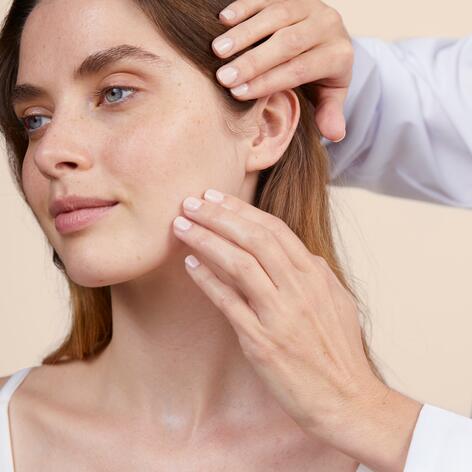Fighting dry skin during cancer treatment
Among the many side effects of cancer treatments, skin dryness is one of the most common. This is especially the case with chemotherapy, which not only targets cancer cells, but sometimes the skin as well. You can take action to alleviate these feelings of tightness. On a daily basis, your main priority is to moisturize.

Against dry skin, prevention is better
Did you know that some of our daily behaviors contribute to dry skin? For example, certain classic hygiene products (solid or liquid soaps) are often aggressive. Prefer washing oils, gels or dermatological breads that respect the hydrolipidic film and gently clean the skin. The water you use to wash yourself is also important. Too hot (above 32 to 34°C) will make your skin even drier and reactivate inflammation. Do not stay too long in your bath or shower to avoid prolonged contact with limescale and chlorine. And when drying, to limit irritation, dab with a towel and avoid rubbing.
Fighting skin dryness from head to toe
Are you familiar with "xerosis"? This is the scientific name for dry skin. It is not uncommon in the treatment of cancer. It is often a simple dryness, with small scales that flake off like dandruff. It may be accompanied by itching or tightness. But it can also be more accentuated, with a cracked appearance on the legs or with cracks on the hands or feet. Even though some parts of the body are less noticeable, you need to take care of them.

One of the most important consequences of the treatments on my skin was extreme dryness. I had to moisturize my skin 4 to 5 times a day!
Mission hydratation
To prevent your skin from drying out, use a moisturizing cream or emollient once or twice a day, giving preference to products with the least amount of ingredients, without preservatives, alcohol or perfume that can irritate.
Pour votre visage
Privilégiez des crèmes hydratantes de textures riches. Appliquez votre soin du bout des doigts sur le front, les joues et le cou. Puis lissez du centre vers les contours du visage. Et en cas de rougeurs, préférez des crèmes apaisantes pour peaux hypersensibles. Vous pouvez aussi utiliser un masque hydratant 1 à 3 fois par semaine en couche épaisse, en laissant poser 5 à 10 minutes. Et pourquoi pas des compresses d'eau thermale, aux vertus apaisantes, sur le visage et cou.
Sans oublier les yeux et les lèvres
Le contour des yeux et les lèvres ont aussi besoin d’hydratation. Pour les premiers, déposez chaque jour, du bout des doigts, un soin apaisant « contour des yeux ». Et pourquoi pas, lorsque vous posez votre masque visage, en profiter pour faire des compresses d’eau thermale sur les paupières ? Pour les lèvres, utilisez un baume stick au cold cream 2 à 3 fois par jour. Point positif : vous pouvez appliquer votre rouge à lèvres par-dessus. Dernier point, si vos lèvres sont gercées, utilisez un baume réparateur.

During treatments, don't forget your scalp
After hair loss, the scalp is extremely sensitive. The skin can become irritated, dry and flaky. Gently wash your head with warm water and massage gently. You can use a gel, a washing oil, a dermatological bar (without soap). After drying gently, apply a moisturizing or anti-itching cream.
Taking care of your scalp during and after chemotherapy
FRIENDLY (AND EXPERT) ADVICE
To moisturize the rest of your body, be gentle!
Start by spreading your emollient between your hands. Then, spread it out in dabs. Finally, massage it into the skin with large, circular movements, gently, without pressing. No need to rub, you could irritate your skin. A council: on a slightly wet skin, the application of the emollient will be even easier.
And don't forget your hands and feet!
Treatments can also dry out the skin on your hands and feet. Hand-foot syndrome (redness or severe dryness on the palms and soles of the feet) is a side effect of some chemotherapy or targeted treatments. This makes you more susceptible to cracking and bleeding. Like the rest of your body, think hydration. Even before you see the first signs of irritation, generously coat your hands or feet with an emollient. Tip: for maximum hydration, at bedtime, or even during the day, after applying a thick layer of cream, cover them with gloves or loose cotton socks.
Take care of your hands and feet during cancer treatment.

Our solutions for dry skin
Eau Thermale Avene skincare products designed to help you feel better about your skin
- Tolérance Control Soothing skin recovery balmNouveau
Tolerance
Tolérance Control Soothing skin recovery balmHydrates - Calms - Strengthens the skin barrier - XeraCalm A.D Lipid-replenishing balmBest Seller
XeraCalm
XeraCalm A.D Lipid-replenishing balmNourishes - Soothes - Hydrates - XeraCalm A.D Soothing concentrateBest Seller
XeraCalm
XeraCalm A.D Soothing concentrateNourishes - Soothes - Restores - Repairs
NEWSLETTER
Always there for your skin!
All our advice to take care of it daily.

Which skin care routine should you adopt?
Identify what it really needs with the help of our experts and discover the most suitable skin care routine for you.




